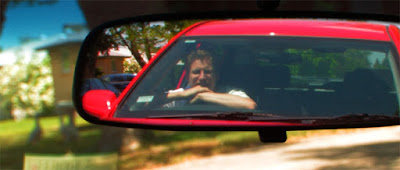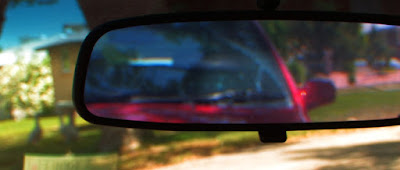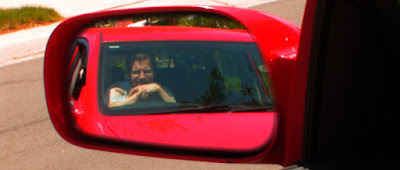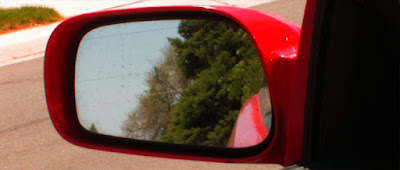So, the tests are in:

Mirror Test1

Original Mirror

Mirror Test2

Original Mirror2
The good news is that this will totally work. The effect is believable, and this will allow us to take the shots we want and even tweak with the framing in post.
The better news is that the tests are all wrong.
I knew I would need to flip the image to compensate for the mirror that is supposed to be there, but I didn't think to flip the camera to the wrong side so that when we flipped it back it would be correct. And so, in both test shots, it looks like the cars in the background (the same car, actually) are about to ram the car from the side. So, on set, we need to make sure to put the camera on the other side of the vehicle.
So if you're ever going to do a special effect, even a really basic one like this, it is best to do tests to make sure everything is correct. Otherwise your totally "buy-able" effect will be ruined by unnatural physics.
We may shoot some more tests just to make sure we know what angle we need to use. If we do, I'll try to get some stills up here for comparison.
~Luke Holzmann
Your Media Production Mentor

2 comments :
I wish I knew what you were talking about:
"I knew I would need to flip the image to compensate for the mirror that is supposed to be there, but I didn't think to flip the camera to the wrong side so that when we flipped it back it would be correct. And so, in both test shots, it looks like the cars in the background (the same car, actually) are about to ram the car from the side. So, on set, we need to make sure to put the camera on the other side of the vehicle."
--"the mirror that is supposed to be there"? --I am completely lost on this comment. The photos you show include a mirror. So why is the mirror to which you refer only "supposed" to be "there"?
--"flip the camera to the wrong side"? (What do you mean when you speak of "flipping" the camera . . . especially when you are flipping it to "the wrong side"? "Wrong side" of what . . . or . . . in what WAY is the "side" wrong?)
--"we need to make sure to put the camera on the other side of the vehicle"? --Since I have no idea what side you were talking about to begin with, I have no idea what "the other" side is to which you here refer.
And your reference to unnatural physics includes a link to . . . the IMDB for Beowulf? The reference is opaque. Perhaps you're making a reference only useful to people on the "inside" (i.e., who happen to have watched Beowulf)?
--I'd like to see how your final movie solutions turned out.
Thanks for commenting!
Most of the confusion is due to the limitations of trying to explain a complex process in stills and text (a skill I am still developing).
It turns out, after more thought, that there would be no need to flip the image that we shoot of the car that we would add in the rear view mirror because we would have already pointed the camera 180 degrees from the angle it was shooting the mirror itself.
In the photos I show the mirror "plate" shot and then the composite of the plate shot and the car we wanted to appear behind the "plate" shot car (wow, this sounds really confusing). So, the difficulty was trying to figure out what angle to shoot the car that would then appear in the rear view mirror. And, initially, I thought I would need to flip the angle of the camera so that when we flipped the image in the composite shot it would look right. This turned out to be a false assumption (I think. I'll post pictures when we get to that point in post).
And, I freely admit that my links are often extremely vague. "Beowulf" is a CG movie (made in a computer after shooting actors wearing tracking balls). The level of detail is amazing, but the reason the movie doesn't feel real is because, even with motion tracking as the basis for the action, the movement felt wrong. In other words, it had very unnatural physics.
Thanks again for stopping by. I hope this helped clarify a few things. If not, please let me know and I'll do my best to make more sense <smile>.
~Luke
Post a Comment